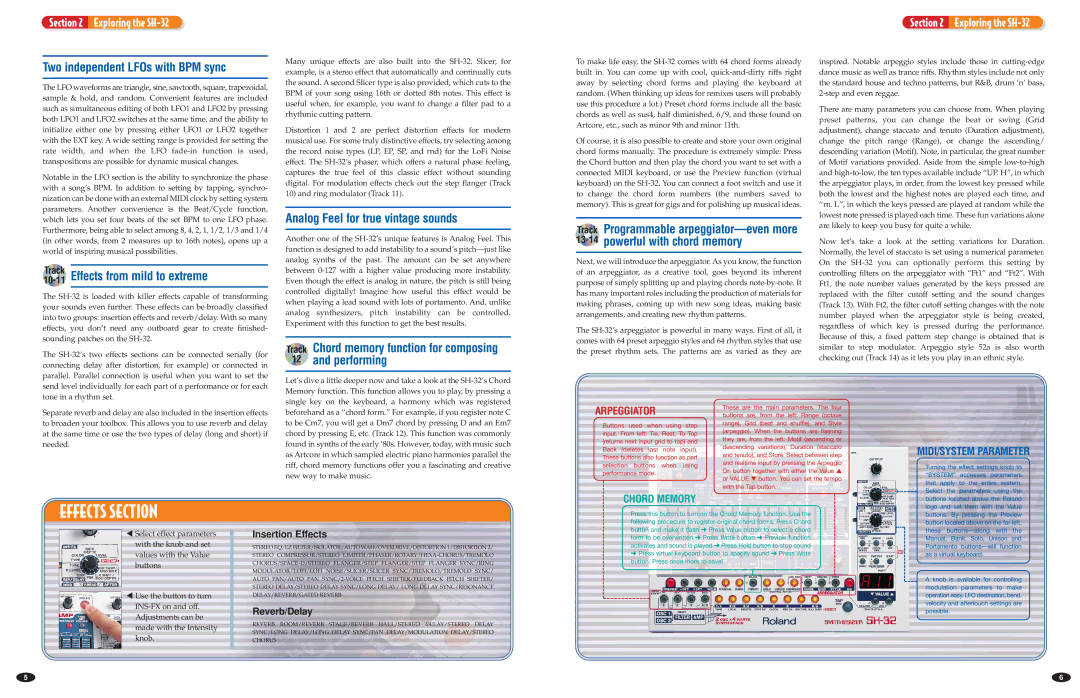
Section 2 Exploring the
Section 2 Exploring the
Two independent LFOs with BPM sync
The LFO waveforms are triangle, sine, sawtooth, square, trapezoidal, sample & hold, and random. Convenient features are included such as simultaneous editing of both LFO1 and LFO2 by pressing both LFO1 and LFO2 switches at the same time, and the ability to initialize either one by pressing either LFO1 or LFO2 together with the EXT key. A wide setting range is provided for setting the rate width, and when the LFO
Notable in the LFO section is the ability to synchronize the phase with a song’s BPM. In addition to setting by tapping, synchro- nization can be done with an external MIDI clock by setting system parameters. Another convenience is the Beat/Cycle function, which lets you set four beats of the set BPM to one LFO phase. Furthermore, being able to select among 8, 4, 2, 1, 1/2, 1/3 and 1/4 (in other words, from 2 measures up to 16th notes), opens up a world of inspiring musical possibilities.
Many unique effects are also built into the
Distortion 1 and 2 are perfect distortion effects for modern musical use. For some truly distinctive effects, try selecting among the record noise types (LP, EP, SP, and rnd) for the LoFi Noise effect. The
Analog Feel for true vintage sounds
Another one of the
To make life easy, the
Of course, it is also possible to create and store your own original chord forms manually. The procedure is extremely simple: Press the Chord button and then play the chord you want to set with a connected MIDI keyboard, or use the Preview function (virtual keyboard) on the
Track Programmable
13-14 powerful with chord memory
inspired. Notable arpeggio styles include those in
There are many parameters you can choose from. When playing preset patterns, you can change the beat or swing (Grid adjustment), change staccato and tenuto (Duration adjustment), change the pitch range (Range), or change the ascending/ descending variation (Motif). Note, in particular, the great number of Motif variations provided. Aside from the simple
Now let’s take a look at the setting variations for Duration. Normally, the level of staccato is set using a numerical parameter.
Track
between
Next, we will introduce the arpeggiator. As you know, the function
On the
10-11 Effects from mild to extreme
The
The
Even though the effect is analog in nature, the pitch is still being controlled digitally! Imagine how useful this effect would be when playing a lead sound with lots of portamento. And, unlike analog synthesizers, pitch instability can be controlled. Experiment with this function to get the best results.
Track Chord memory function for composing
12and performing
Let’s dive a little deeper now and take a look at the
of an arpeggiator, as a creative tool, goes beyond its inherent purpose of simply splitting up and playing chords
The
controlling filters on the arpeggiator with “Ft1” and “Ft2”. With Ft1, the note number values generated by the keys pressed are replaced with the filter cutoff setting and the sound changes (Track 13). With Ft2, the filter cutoff setting changes with the note number played when the arpeggiator style is being created, regardless of which key is pressed during the performance. Because of this, a fixed pattern step change is obtained that is similar to step modulator. Arpeggio style 52a is also worth checking out (Track 14) as it lets you play in an ethnic style.
Separate reverb and delay are also included in the insertion effects to broaden your toolbox. This allows you to use reverb and delay at the same time or use the two types of delay (long and short) if needed.
beforehand as a “chord form.” For example, if you register note C to be Cm7, you will get a Dm7 chord by pressing D and an Em7 chord by pressing E, etc. (Track 12). This function was commonly found in synths of the early ‘80s. However, today, with music such as Artcore in which sampled electric piano harmonies parallel the riff, chord memory functions offer you a fascinating and creative new way to make music.
ARPEGGIATOR
Buttons used when using step input. From left: Tie, Rest, To Top (returns next input grid to top) and Back (deletes last note input). These buttons also function as part selection buttons when using performance mode.
CHORD MEMORY
These are the main parameters. The four buttons are, from the left: Range (octave range), Grid (beat and shuffle), and Style (arpeggio). When the buttons are flashing they are, from the left: Motif (ascending or descending variations), Duration (staccato and tenuto), and Store. Select between step and realtime input by pressing the Arpeggio On button together with either the Value ▲ or VALUE ▼ button. You can set the tempo with the Tap button.
MIDI/SYSTEM PARAMETER
Turning the effect settings knob to “SYSTEM” accesses parameters that apply to the entire system. Select the parameters using the buttons located above the Roland
logo and set them with the Value
EFFECTS SECTION
▼ Select effect parameters with the knob and set values with the Value buttons
▼ Use the button to turn
Insertion Effects
STEREO EQ/EZ FILTER/ISOLATOR/AUTO WAH/OVERDRIVE/DISTORTION 1/DISTORTION 2/ STEREO COMPRESSOR/STEREO
Reverb/Delay
REVERB ROOM/REVERB STAGE/REVERB HALL/STEREO DELAY/STEREO DELAY SYNC/LONG DELAY/LONG DELAY SYNC/PAN DELAY/MODULATION DELAY/STEREO CHORUS
Press this button to turn on the Chord Memory function. Use the following procedure to register original chord forms: Press Chord button and make it flash ➜ Press Value button to select a chord form to be overwritten ➜ Press Write button ➜ Preview function activates and sound is played ➜ Press Hold button to stop sound
➜Press virtual keyboard button to specify sound ➜ Press Write button. Press once more to save!
buttons. By pressing the Preview button located above on the far left, these
A knob is available for controlling modulation parameters to make operation easy. LFO destination, bend, velocity and aftertouch settings are possible.
5 | 6 |
